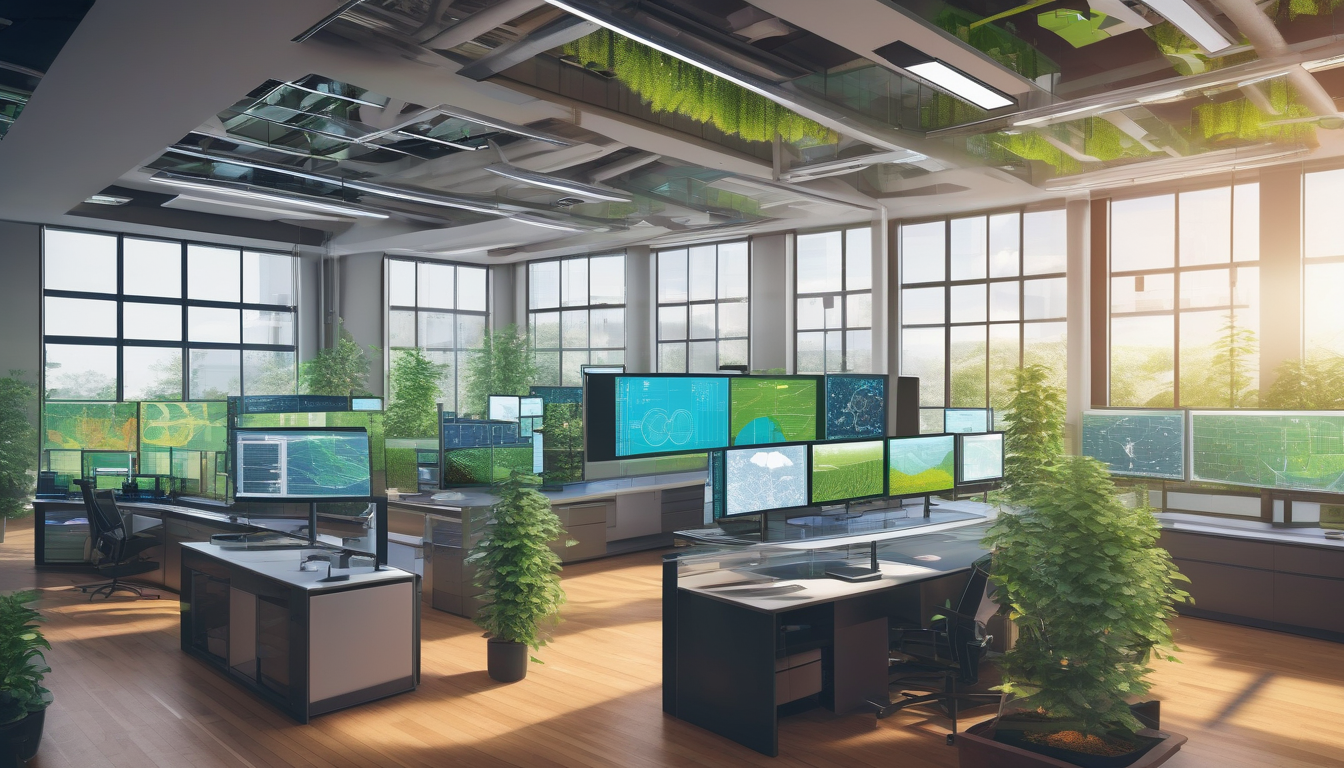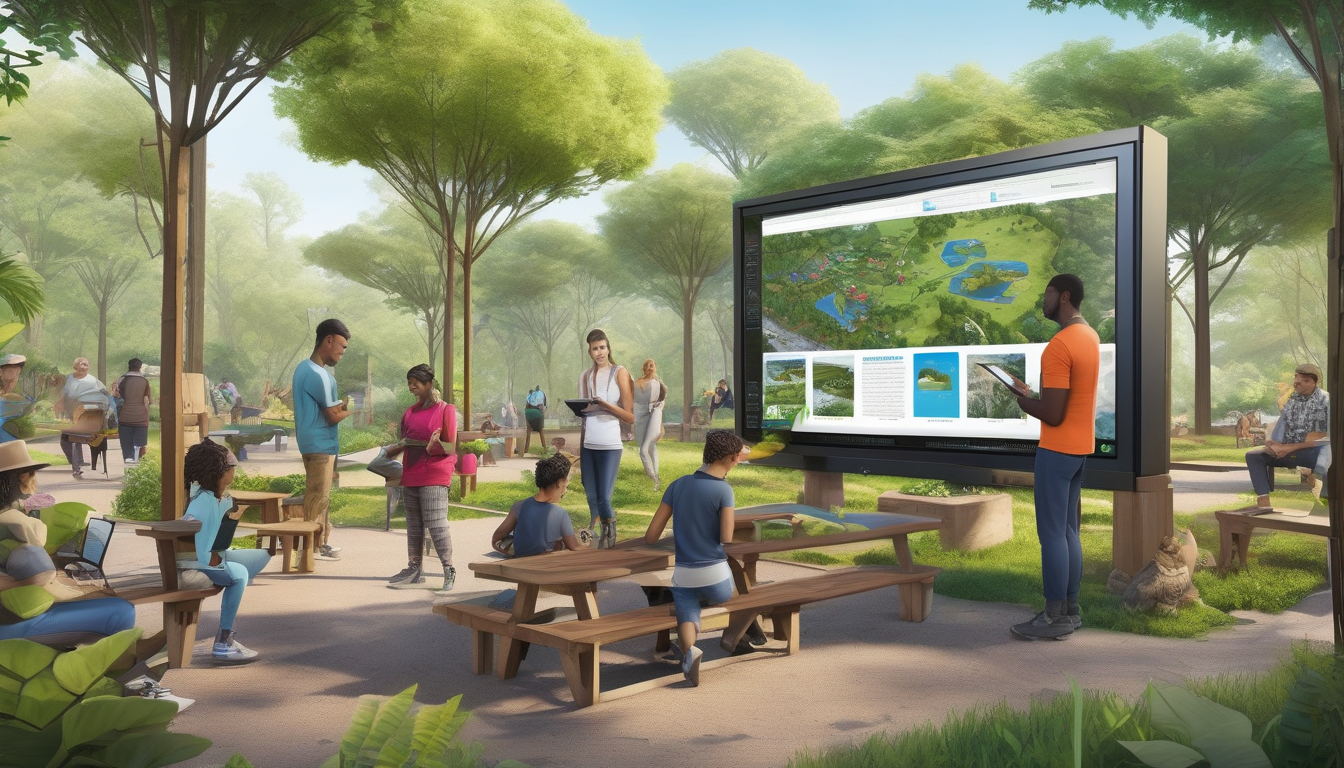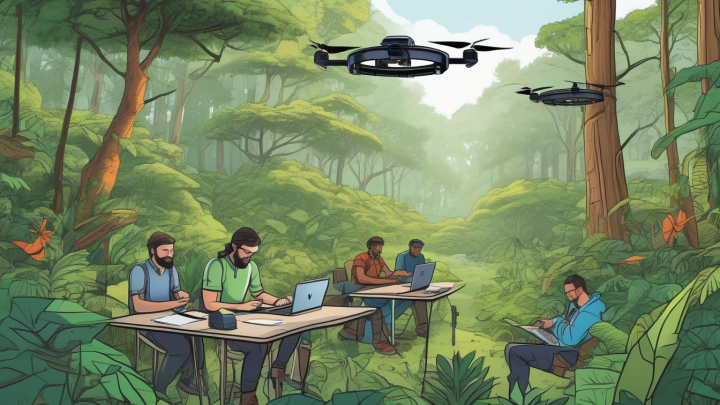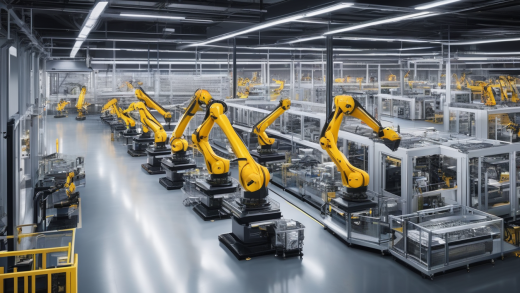In today’s rapidly changing world, the intersection of technology and environmental conservation is more crucial than ever. Artificial Intelligence (AI) is stepping up to the plate, transforming how we approach conservation efforts. Imagine having a digital ally that can sift through mountains of data faster than any human could, pinpointing critical areas that need attention. This isn’t science fiction; it’s the reality of AI in action. By improving data analysis, monitoring ecosystems, and facilitating sustainable practices, AI is paving the way for more effective conservation strategies.
Artificial intelligence technologies are revolutionizing wildlife monitoring by enabling real-time data collection and analysis. Gone are the days of waiting weeks or months to gather data on animal populations and behaviors. With AI, conservationists can track these metrics efficiently, allowing for quicker responses to changes in wildlife patterns. Imagine being able to monitor the heartbeat of an ecosystem in real-time! This capability is critical in ensuring that endangered species receive the protection they need before it’s too late.
AI’s predictive analytics capabilities are a game changer for understanding climate change impacts. Researchers can model various scenarios, providing valuable insights that help policymakers develop effective mitigation and adaptation strategies. For instance, AI can analyze historical climate data and predict future trends, allowing us to prepare for potential environmental shifts. This proactive approach is essential for safeguarding vulnerable ecosystems and ensuring that our planet remains habitable for future generations.
Innovative data collection techniques powered by AI, such as remote sensing and drone technology, are enhancing our ability to gather crucial environmental data with greater accuracy and efficiency. Remote sensing applications utilize AI to analyze satellite imagery, helping identify deforestation, habitat loss, and changes in land use. These insights are critical for conservation efforts, allowing us to take action before it’s too late. Meanwhile, drones equipped with AI can survey large areas quickly, monitor wildlife, and assess habitat conditions, making them invaluable tools for conservationists working in remote or difficult terrains.
AI is enabling the development of targeted conservation strategies by analyzing data trends and identifying areas that require immediate attention or intervention. This data-driven approach ensures that resources are allocated effectively, maximizing the impact of conservation efforts.
AI tools also play a significant role in fostering community engagement in conservation efforts. By providing platforms for sharing information and gathering citizen science data, AI raises awareness about local environmental issues. This engagement is vital; when communities understand their ecosystems, they are more likely to take action to protect them.
AI-powered citizen science initiatives encourage public participation in data collection, allowing communities to contribute to conservation efforts while enhancing their understanding of local ecosystems. This collaboration not only empowers individuals but also enriches the data available for conservationists.
Lastly, AI can enhance educational programs by providing interactive learning experiences that inform individuals about environmental issues and inspire action towards conservation efforts. Imagine a classroom where students learn about climate change through immersive AI simulations, fostering a new generation of environmentally conscious citizens.

AI in Wildlife Monitoring
Artificial intelligence technologies are revolutionizing wildlife monitoring in ways we could only dream of a few years ago. Imagine being able to track animal populations in real-time, as if you had a magical window into the wild. With AI’s advanced data collection and analysis capabilities, conservationists can now monitor animal behaviors more efficiently than ever before, leaving traditional methods in the dust.
One of the most exciting aspects of AI in wildlife monitoring is its ability to process vast amounts of data quickly. For instance, AI algorithms can analyze camera trap images or audio recordings from the field, identifying species and counting individuals with remarkable accuracy. This not only saves time but also reduces human error, which can be a significant factor in wildlife studies. Think of it as having a super-smart assistant that never tires and can sift through thousands of images in the blink of an eye!
Furthermore, AI can enhance wildlife monitoring through various innovative techniques. Here are a few key applications:
- Real-Time Tracking: AI can utilize GPS data to track animal movements and behaviors in real-time, providing insights into their habitats and migration patterns.
- Predictive Modeling: By analyzing historical data, AI can predict future population trends and help conservationists make informed decisions.
- Behavioral Analysis: Machine learning algorithms can analyze patterns in animal behavior, allowing researchers to understand how they interact with their environment.
In essence, AI is not just a tool; it’s a game changer in wildlife conservation. By providing deeper insights and more accurate data, it empowers conservationists to make better decisions and implement more effective strategies. The future of wildlife monitoring is bright, thanks to AI, and it’s paving the way for a more sustainable coexistence between humans and wildlife.

Predictive Analytics for Climate Change
In the face of climate change, predictive analytics powered by artificial intelligence is emerging as a game changer. Imagine having a crystal ball that not only forecasts the future but also helps us understand the intricate web of environmental changes. This technology allows researchers to model the impacts of climate change with unprecedented accuracy, turning complex data into actionable insights. With AI, we can predict how rising temperatures, shifting weather patterns, and extreme events will affect vulnerable ecosystems.
One of the most exciting aspects of AI in this context is its ability to analyze vast amounts of data from diverse sources. By integrating information from satellite imagery, weather stations, and historical climate records, AI can identify trends that may not be visible to the naked eye. For instance, it can highlight regions at risk of drought or flooding, enabling policymakers to take proactive measures. This predictive capability is not just about forecasting; it’s about empowering decision-makers with knowledge.
Consider the following key applications of AI-driven predictive analytics:
- Impact Assessment: AI models can simulate the effects of various climate scenarios, helping to forecast outcomes based on different levels of greenhouse gas emissions.
- Resource Allocation: By predicting where climate impacts will be most severe, governments and organizations can allocate resources more effectively, ensuring that aid reaches those who need it most.
- Policy Development: Insights gained from predictive analytics can guide the creation of policies aimed at both mitigation and adaptation, ensuring that they are grounded in data rather than guesswork.
In summary, the fusion of AI and predictive analytics offers a powerful tool for tackling climate change. It not only enhances our understanding of potential future scenarios but also equips us with the means to act decisively. As we continue to face environmental challenges, leveraging these technologies will be crucial in safeguarding our planet for future generations.
Data Collection Techniques
In the realm of environmental conservation, have undergone a remarkable transformation, thanks to the integration of artificial intelligence (AI). Traditional methods of gathering data often fell short in terms of efficiency and accuracy, but with AI, conservationists can now harness innovative technologies that revolutionize how we monitor ecosystems. Imagine having the ability to collect data from the most remote corners of the earth without disturbing the wildlife or the environment—this is now a reality.
One of the most exciting advancements in data collection is the use of remote sensing. This technique involves analyzing satellite imagery to gather information about vast landscapes. AI algorithms can process this data to detect critical changes such as deforestation, habitat loss, and shifts in land use. For instance, AI can identify areas where trees have been cut down or where urban development is encroaching on natural habitats, providing essential insights for conservationists.
Another groundbreaking tool in the conservation toolkit is drone technology. Drones equipped with AI capabilities can cover large areas quickly and efficiently, monitoring wildlife populations and assessing habitat conditions. They are particularly useful in hard-to-reach regions, allowing conservationists to gather data without the need for extensive ground surveys. With drones, we can not only observe animal behaviors but also collect vital statistics on their habitats, making them indispensable for modern conservation efforts.
Moreover, the combination of these technologies leads to a synergistic effect. For example, data collected via drones can be cross-referenced with satellite imagery to create a comprehensive picture of an ecosystem’s health. This holistic approach enables conservationists to make informed decisions, allocate resources effectively, and implement targeted interventions where they are most needed.
In conclusion, the future of conservation lies in the hands of AI-powered data collection techniques. These innovations not only enhance our understanding of the environment but also empower us to take meaningful action to protect it.
Remote Sensing Applications
Remote sensing applications are a game-changer in the field of environmental conservation. By utilizing advanced satellite imagery and aerial data, these technologies allow conservationists to monitor vast areas of land with incredible precision. Imagine being able to see changes in forest cover or detect illegal logging activities from space! This is not science fiction; it’s the power of artificial intelligence combined with remote sensing.
One of the most significant advantages of remote sensing is its ability to provide real-time data. Conservationists can quickly identify critical areas that are experiencing rapid environmental changes, such as deforestation, habitat loss, and alterations in land use. This timely information is crucial for implementing effective conservation strategies before it’s too late.
For instance, AI algorithms can analyze satellite images to detect patterns that might indicate ecological distress. These patterns can include:
- Changes in vegetation health
- Soil erosion
- Water body pollution
Furthermore, remote sensing technologies can be integrated with machine learning to enhance their predictive capabilities. By analyzing historical data, AI can forecast future environmental changes, allowing conservationists to plan proactive measures. This synergy between AI and remote sensing not only improves data accuracy but also enables better decision-making.
In summary, remote sensing applications are revolutionizing the way we approach environmental conservation. By harnessing the power of AI, these technologies provide invaluable insights that drive more effective conservation efforts. As we continue to face environmental challenges, leveraging these tools will be essential in safeguarding our planet’s biodiversity for future generations.
Drone Technology in Conservation
In the realm of environmental conservation, drone technology is emerging as a game-changer. Imagine having the ability to monitor vast stretches of land in a fraction of the time it would take on foot. Drones, equipped with advanced AI, are not just flying cameras; they are powerful tools that provide conservationists with real-time data and insights. This technology allows experts to survey areas that are often difficult to access, making it easier to gather crucial information about wildlife and their habitats.
One of the most remarkable aspects of drone technology is its versatility. Drones can be fitted with various sensors and cameras, enabling them to:
- Conduct aerial surveys of wildlife populations
- Monitor changes in habitat conditions
- Track illegal poaching activities
For instance, in regions where endangered species roam, drones can fly over these areas, capturing high-resolution images that help researchers assess population sizes and health. This method is not only efficient but also minimizes human disturbance in sensitive habitats. Furthermore, the data collected can be processed using AI algorithms to identify trends and anomalies, providing valuable insights that guide conservation strategies.
Moreover, drone technology is proving invaluable in the fight against deforestation. By utilizing remote sensing capabilities, drones can detect changes in forest cover over time, allowing for timely interventions. For example, if a drone identifies a sudden increase in logging activity, conservationists can act quickly to investigate and mitigate the situation. This proactive approach is essential for preserving biodiversity and maintaining ecosystem balance.
In summary, the integration of drone technology into conservation efforts is not just a trend; it’s a revolution. As these tools become more accessible and affordable, the potential for enhanced monitoring and protection of our planet’s precious ecosystems will only continue to grow.
AI-Driven Conservation Strategies
Artificial Intelligence is not just a buzzword; it’s a game-changer in the realm of conservation strategies. By harnessing the power of AI, conservationists can now analyze vast amounts of data in a fraction of the time it would take using conventional methods. Imagine having a super-smart assistant that can sift through mountains of information, pinpointing areas that need immediate attention. This capability allows for targeted interventions that can significantly enhance the effectiveness of conservation efforts.
For instance, AI algorithms can identify patterns in animal migration, habitat usage, and even poaching activities. This data-driven approach enables conservationists to allocate resources more efficiently, ensuring that critical areas receive the focus they need. One fascinating application involves using AI to analyze acoustic data from the environment, which helps in identifying the presence of endangered species by recognizing their calls.
Moreover, AI-driven conservation strategies are not limited to just wildlife monitoring. They extend to managing entire ecosystems. By analyzing environmental data, AI can help predict the impacts of climate change on specific habitats, allowing for proactive measures to be implemented. For example, if AI predicts a decline in a particular species due to habitat loss, conservationists can act swiftly to implement protective measures or restoration projects.
To illustrate the potential of AI in conservation, consider the following table that summarizes some key AI applications and their benefits:
| AI Application | Benefit |
|---|---|
| Wildlife Tracking | Real-time population monitoring |
| Habitat Assessment | Identifying critical areas for intervention |
| Climate Impact Modeling | Proactive conservation planning |
In conclusion, AI is paving the way for a new era of conservation strategies that are not only more effective but also more sustainable. By leveraging technology, we can ensure that our efforts to protect the environment are not just reactive but proactive, ultimately leading to a healthier planet for future generations.

Community Engagement through AI
Artificial Intelligence (AI) isn’t just a tool for scientists and researchers; it’s also a powerful ally in rallying communities around environmental conservation. By providing platforms that facilitate information sharing and collaboration, AI is transforming how local populations engage with and contribute to conservation efforts. Imagine a neighborhood where every resident can easily report changes in wildlife or environmental conditions—this is becoming a reality thanks to AI.
One of the most exciting aspects of AI in community engagement is its ability to harness citizen science. This concept invites everyday people to participate in data collection, enabling them to play an active role in monitoring their local ecosystems. For instance, AI-powered apps can guide users to identify and report sightings of endangered species, helping conservationists gather valuable data while fostering a sense of community ownership. The more people involved, the richer the data becomes, leading to better conservation outcomes.
Moreover, educational programs enhanced by AI provide interactive learning experiences that captivate and inspire individuals. These programs can include virtual reality simulations that allow users to explore endangered habitats or gamified learning modules that teach about local wildlife. By making learning engaging and accessible, AI encourages people to take action and participate in conservation initiatives.
To illustrate the impact of AI on community engagement, consider the following table that outlines key benefits:
| Benefit | Description |
|---|---|
| Increased Participation | AI tools empower more individuals to contribute to conservation efforts, leading to a larger pool of data and insights. |
| Enhanced Data Accuracy | With AI, data collected by citizens can be analyzed for accuracy, ensuring reliable information for conservation strategies. |
| Community Awareness | AI fosters a greater understanding of local environmental issues, motivating communities to take proactive steps towards conservation. |
In conclusion, AI is not just about technology; it’s about people coming together to protect the environment. By engaging communities through innovative tools and educational programs, we can create a stronger, more informed movement towards conservation that benefits everyone.
Citizen Science Initiatives
Citizen science initiatives are a game-changer in the realm of environmental conservation. They empower everyday people to engage in scientific research, contributing valuable data that can bolster conservation efforts. Imagine a world where your smartphone can help track endangered species or monitor local air quality—this is not just a dream; it’s happening right now!
By utilizing AI technologies, these initiatives allow communities to actively participate in data collection and analysis, fostering a sense of ownership and responsibility towards their local ecosystems. For instance, apps designed for reporting wildlife sightings can significantly enhance the data available to researchers. With just a few taps on a screen, individuals can contribute to a larger database, helping conservationists make informed decisions.
Moreover, citizen science projects often focus on educating participants about their environment. When people understand the significance of their contributions, they are more likely to engage in sustainable practices. This educational aspect is crucial, as it not only informs the public about local biodiversity but also inspires action. Think of it as planting seeds of knowledge that can grow into a forest of awareness and commitment to conservation.
Some notable examples of citizen science initiatives include:
- eBird: A platform that allows bird watchers to record their sightings, contributing to a global database used for tracking bird populations.
- iNaturalist: An app where users can share photos of plants and animals, helping researchers monitor biodiversity and species distribution.
- Project Noah: A platform that encourages the public to document wildlife sightings, aiding in the study of ecosystems and species behavior.
In conclusion, citizen science initiatives not only enhance data collection for conservation purposes but also engage and educate the community. By harnessing the power of AI, these programs create a collaborative environment where everyone can contribute to the preservation of our planet. So, are you ready to take part in this exciting movement and make a difference?
Educational Programs
In today’s fast-paced world, education plays a pivotal role in shaping our understanding of environmental issues and fostering a sense of responsibility towards conservation efforts. AI is stepping up to the plate, transforming traditional educational programs into engaging, interactive experiences that captivate the minds of learners of all ages. Imagine a classroom where students can explore ecosystems through virtual reality, or where they can analyze real-time data from wildlife monitoring projects. This is not just a dream; it’s happening now!
AI-enhanced educational programs provide a unique platform for individuals to dive deep into environmental science. For instance, learners can utilize AI-driven simulations to visualize the impact of climate change on various ecosystems. This hands-on approach not only enhances comprehension but also ignites a passion for conservation. By integrating technology into education, we are preparing the next generation of environmental stewards.
Moreover, these programs often include community involvement components, where students can engage in citizen science projects. This allows them to contribute to real-world data collection, fostering a sense of ownership and empowerment. Through these initiatives, participants can:
- Collect data on local wildlife populations.
- Monitor changes in their environment.
- Communicate findings with their communities.
Additionally, AI can personalize learning experiences, adapting content to fit the unique needs and interests of each student. This ensures that the material is not only relevant but also resonates with the learner, making the educational journey both enjoyable and impactful. As we harness the power of AI in education, we are not just teaching about environmental conservation; we are inspiring action and cultivating a generation that is ready to tackle the challenges of our planet.
In conclusion, AI-driven educational programs are revolutionizing how we approach environmental issues, making learning more accessible, engaging, and effective. By empowering individuals with knowledge and tools, we are paving the way for a brighter, more sustainable future.
Frequently Asked Questions
- How is AI used in wildlife monitoring?
AI enhances wildlife monitoring by allowing conservationists to collect and analyze data in real-time. This means they can track animal populations and behaviors more efficiently, providing insights that traditional methods simply can’t match.
- What role does predictive analytics play in addressing climate change?
Predictive analytics powered by AI helps researchers model the impacts of climate change, offering valuable insights for policymakers. This data is crucial for developing effective strategies to mitigate and adapt to changes in vulnerable ecosystems.
- How do remote sensing and drones improve data collection?
Remote sensing and drone technology utilize AI to gather environmental data with greater accuracy and efficiency. Drones can cover large areas quickly, while remote sensing analyzes satellite imagery to identify critical issues like deforestation and habitat loss.
- What are citizen science initiatives and how do they relate to AI?
Citizen science initiatives leverage AI to encourage public participation in data collection. These programs allow communities to contribute to conservation efforts, enhancing their understanding of local ecosystems while gathering valuable data.
- How can AI enhance educational programs about environmental issues?
AI can create interactive learning experiences that engage individuals in environmental education. By making complex topics more accessible, AI inspires action and awareness regarding conservation efforts.



